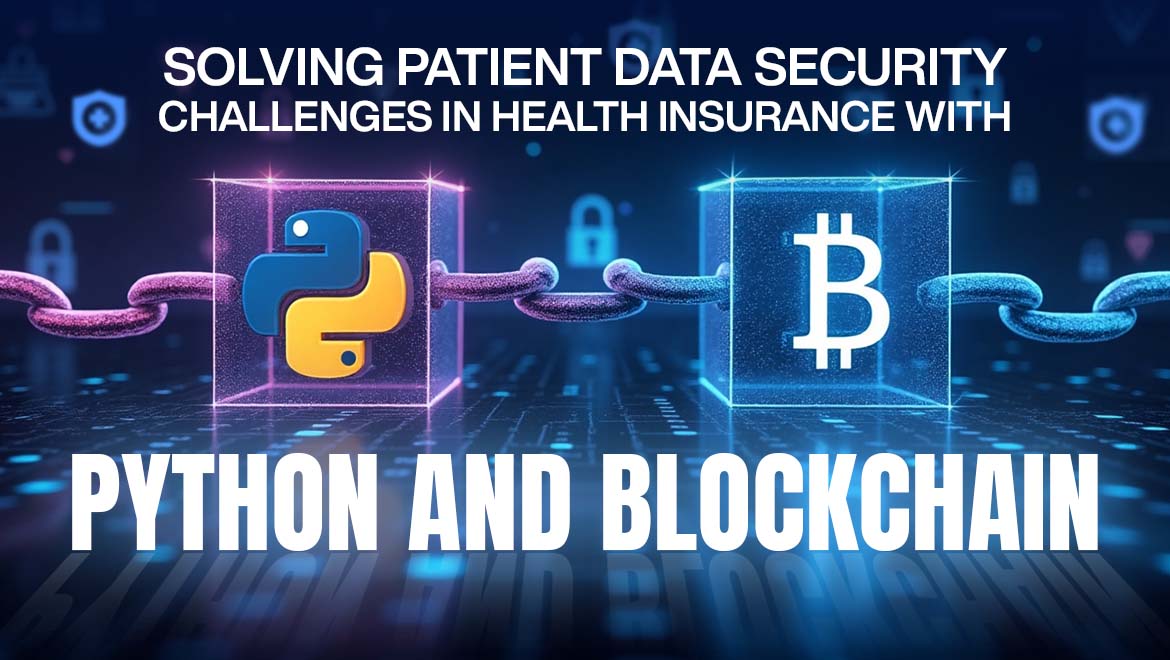

- By Admin
- 05 August, 2025
- 8 min Read
Solving Patient Data Security Challenges in Health Insurance with Python and Blockchain
Patient data is sensitive and fragile: one careless API call, one missed patch, or one sloppy audit, and you don't just face fines. You lose people's trust. In health insurance, it's a business. As cyber threats increase and regulators scrutinize every step, insurers need systems that are secure, transparent, and accountable. It is not paperwork masquerading as protection.
At ACI, compliance isn't an add-on; it's built in. Our approach uses practical engineering for Python and blockchain integration. It combines Python's ease of use with blockchain's security. This blog discovers how HIPAA-ready systems work in the real world.
What’s Still Broken in HIPAA Compliance? Let’s Look into the Problem
Many insurers talk about compliance but still stumble on the same things:
- Data leaks from insecure APIs or shared services.
- Easily editable, and thus easily doubted, audit logs.
- Consent that lives in spreadsheets or email threads.
- Inconsistent or incomplete encryption and reporting.
Even a small mistake, on purpose or by accident, can lead to big fines, harm to reputation, or government action. But following HIPAA's rules isn't just about checking off a list. It means making necessary changes in how systems are built and secured from the ground up.
ACI's Approach: Engineering Compliance with Python and Blockchain
At ACI, we design and deploy the systems that enforce compliance, rather than just advising on it. Patients are in control, with their consent managed easily and with full transparency, ensuring end-to-end security, traceability, and trust.
How Did Python Become the Backbone of HIPAA-First Innovation?
Python is our choice for building things quickly and securely. It's easy to read, test, and has strong crypto and web frameworks. This means we can develop rapidly without sacrificing quality.
1. Robust Encryption and Granular Access Control
We use super strong AES-256 encryption for all your data, like a digital vault! We do this with awesome libraries such as cryptography, PyCrypto, and Fernet, all built right into our Django/Flask system.
What does that mean for you?
- We make sure only people who absolutely need to access specific information for their job can actually see it.
- We keep your sessions safe by automatically logging out inactive users and using special security rules to prevent any sneaky business.
- Our system assigns different roles. So, we can always track exactly who accessed what and when. It's all about accountability!
2. Automatic Records of What Happens
We keep a detailed, real-time log of everything that happens to sensitive patient data. We then show these records in ElasticSearch/Kibana. So we can always prove its security.
This helps us:
- Get instant alerts if anyone breaks the rules or does something suspicious.
- We keep a crystal-clear, unchangeable record of everything that happens.
- You can see a full history of every time your protected health information (PHI) is accessed.
3. How We Securely Handle and Process Your Files
We process your data through secure channels. We clean it up and only keep the absolutely necessary Protected Health Information (PHI). Your PHI is handled by HIPAA-secure ETL pipelines.
This makes sure of a few things:
- We only gather the health information that's truly essential. We can double-check it for accuracy as soon as we get it.
- Any personal details are hidden or made anonymous before we save them.
- We have automatic rules for how long we hold onto data, and these rules are applied while we're processing it.
Blockchain: Delivering Proof, Not Just Promises!
Traditional logs are editable. Blockchain provides tamper-proof records and decentralized trust.
1. Blockchain for Immutable Audit Trails
On private blockchains, like Hyperledger Fabric, every time protected health information (PHI) is accessed, it's recorded as a permanent and unchangeable entry. This entry is always timestamped and secured with a digital signature.
This ensures:
- Demonstrable compliance.
- No fear of past changes going unnoticed.
- Clear responsibility for everyone involved: providers, insurers, and auditors.
2. Smart Contracts for Consent Management
We use smart contracts to help insurers implement dynamic consent models. Patients can grant, limit, or revoke access to PHI with full transparency.
Patient access means:
- You can't see your health info unless you agree to the rules.
- Every time someone looks at your info, it's recorded online so the government can check it.
- Both you and your doctor can see who looked at your info whenever you want.
3. Decentralized Identity Verification
Use special online ID systems that are super secure. These can be your fingerprint or a secret code. It makes it harder for someone to pretend to be you.
Insurance companies like this because:
- They can check your identity without needing a big database.
- It's easy for patients and doctors to sign up and get access.
Making New Medicines Faster and Better
Finding and making new medicines takes a really long time, usually more than ten years, and costs billions of dollars. But new advancements in tech are changing this by:
| Component | Tech | Purpose |
|---|---|---|
| API Gateway | Flask/Django + OAuth2 | Auth, RBAC, session control |
| Audit Logging | Python + Elasticsearch | Live monitoring & forensic trails |
| Consent | Hyperledger Fabric + Smart Contracts | Enforceable patient authorization |
| Data Transfer | Python + SFTP/TLS 1.3 | Secure ingestion & validation |
| Identity | Blockchain + Biometric/MFA | Fraud-resistant identity |
Aryabh Consulting Inc. offers a tightly integrated, compliance-centric, future-ready platform specifically designed for healthcare insurers, a unique advantage over generic IT vendors.
What Makes Aryabh Consulting Inc. Stand Out?
Off-the-shelf tools promise compliance. ACI delivers bespoke systems. It is purpose-built, security-first, and shaped by deep healthcare experience. Because real HIPAA readiness isn't bought, it's engineered.
- You can actually see how we work: Auditors can check our code, not just fancy presentations.
- We build for real-world rules: Our designs match what the experts at OCR and CMS expect.
- We're ready for anything: Healthcare rules and cyber threats change, and so do we!
Compliance shouldn't be a checkbox. It's the backbone of patient trust, and that trust has real value.

